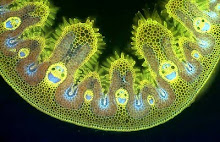Until the harsh winter of 2009-10 I had a 3m. tall specimen of this lovely Californian shrub growing in my back garden, but sadly the severity of that winter killed it and I haven't yet got around to planting another. It comes from the foothills of the Sierra Nevada, thriving in nutritionally poor soil - which explains why it did do well when it was rooted close to my leylandii hedge, in a very dry spot where nothing else will grow. It's also a good wall shrub, doing well in the rubble around the foundations of a house and trained against a south-facing wall.
The flowers are interesting because, like those of hellebores, the parts that look like petals are actually the sepals - there are no true petals.
It's a very prolific producer of nectar (you can see nectar drops glistening in the image above) so bumblebees love it.
You do need to be careful when you prune the plant though, because the densely hairy stems and leaves (which account for its name of flannel bush) can cause skin irritation. The cultivar that's most often sold in Britain is usually labelled California Glory.
The plant has traditionally been classified in the family Sterculiaceae, but modern phylogenic studies by the Angiosperm Phylogeny Group, based on DNA sequence data that gives a more accurate reflection of evolutionary relationships, place it in the mallow family - the Malvaceae. Gardeners, and sometimes even professional botanists, often deplore the way in which plant scientific names and classification change so often but they shouldn't - it reflects the fact that someone, somewhere is still taking an interest in the world's flora and that traditional taxonomic botany isn't totally moribund in universities.
Fremontodendron, also know under the synonym of Fremontia, was first discovered by General Fremont near Sacramento in 1846 and was named after him - you can read an account of the colourful life of this soldier, explorer, anti-slavery campaigner, politician and plant collector here.






















